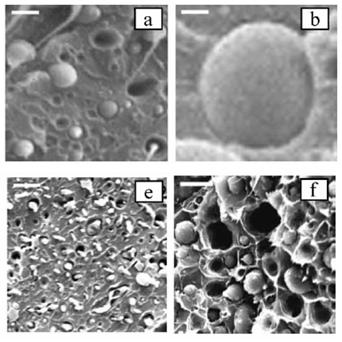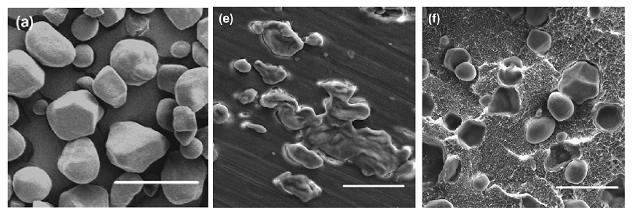Torkelson Research Group
|
Torkelson Research Group |
Novel Materials Made by Solid-State Shear PulverizationSolid-state shear pulverization (SSSP) is a novel mechanical process that uses a modified twin-screw extruder with cooling zones to maintain the polymer in the solid state during processing. High shear and compressive forces result in repeated fragmentation and fusion of polymer in the solid state producing excellent mixing and dispersion of polymer blends and nanocomposites. The SSSP process has been shown to yield nanostructured polymer blends and nanocomposites that cannot be made (due to kinetic and thermodynamic barriers) using conventional processing techniques.
Under certain conditions, SSSP can form block copolymers in situ leading to improved blend compatibilization. Interpolymer radical coupling reaction leading to block copolymer formation was demonstrated for the first time in the solid state and in the absence of diffusion using SSSP. Fluorescence-detection GPC was used to detect the interpolymer reaction of labeled PS polymer with unlabeled PS and PMMA polymer. Annealing studies of copulverized immiscible blends demonstrated that the number-average dispersed phase diameter is stable to long-term annealing while the coalescence of the dispersed phase is present during annealing of similar blends processed by twin-screw extrusion. The images on the right show micrographs of two SSSP-blended systems before (a, c) and after (b, d) annealing. The systems are PS/PMMA (a, b) and PS/HDPE (c, d) A.H. Lebovitz, K. Khait, and J.M. Torkelson, "Stabilization of Dispersed Phase to Static Coarsening: Polymer Blend Compatibilization via Solid-State Shear Pulverization," Macromolecules 35, 8672 (2002). [Link] A.H. Lebovitz, K. Khait, and J.M. Torkelson, "In Situ Block Copolymer Formation during Solid-State Shear Pulverization: An Explanation for Blend Compatibilization via Interpolymer Radical Reactions," Macromolecules 35, 9716 (2002). [Link] Immiscible Blend Compatibilization via Addition of Block and Gradient Copolymers during SSSP  SSSP of PS/PMMA blends yields material with quasi-nanostructured morphology and dispersed-phase domains exhibiting length scales of order 100 nm or less. However, the pulverized blend exhibits significant coarsening of the dispersed-phase domains during static annealing, leading to loss of the original nanostructure. Addition of S/MMA gradient copolymer material during pulverization yields a nanostructure nearly identical to that of the blend without copolymer and a near total suppression of coarsening during annealing. Studies of SEBS triblock copolymer addition to a PS/HDPE blend demonstrate partial to full blend compatibilization. In contrast, much weaker compatibilization effects were observed for the addition of block copolymer during melt processing. The image shows micrographs of an 80/20 wt% PS/HDPE blend without copolymer before (a) and after (b) annealing, as well as a blend with SEBS triblock copolymer before (e) and after (f) annealing.
SSSP of PS/PMMA blends yields material with quasi-nanostructured morphology and dispersed-phase domains exhibiting length scales of order 100 nm or less. However, the pulverized blend exhibits significant coarsening of the dispersed-phase domains during static annealing, leading to loss of the original nanostructure. Addition of S/MMA gradient copolymer material during pulverization yields a nanostructure nearly identical to that of the blend without copolymer and a near total suppression of coarsening during annealing. Studies of SEBS triblock copolymer addition to a PS/HDPE blend demonstrate partial to full blend compatibilization. In contrast, much weaker compatibilization effects were observed for the addition of block copolymer during melt processing. The image shows micrographs of an 80/20 wt% PS/HDPE blend without copolymer before (a) and after (b) annealing, as well as a blend with SEBS triblock copolymer before (e) and after (f) annealing.
Y. Tao, A.H. Lebovitz, and J.M. Torkelson, "Compatibilizing Effects of Block Copolymer Mixed with Immiscible Polymer Blends by Solid-State Shear Pulverization: Stabilizing the Dispersed Phase to Static Coarsening," Polymer 46, 4753-4761 (2005). [Link] Y. Tao, J. Kim, and J.M. Torkelson, "Achievement of Quasi-Nanostructured Polymer Blends by Solid-State Shear Pulverization and Compatibilization by Gradient Copolymer Addition," Polymer 47, 6773-6781 (2006). [Link] Creation of Composites from Biobased Polymers  SSSP was used to prepare blends or composites of polyethylene (PE) and starch. This solid-state process resulted in damaged granular structures (surface roughening, cracking, and clustering), a result that is not achieved in polymer/starch blends made by melt mixing. This is the first time that damage to starch granule morphology has been reported in polymer/starch blends or composites. These morphological changes result in improved permeation and mechanical properties compared to the melt-mixed blends. The images show as received starch granules (left) and HDPE/starch blends made by pulverization (middle) and melt-mixing (right).
SSSP was used to prepare blends or composites of polyethylene (PE) and starch. This solid-state process resulted in damaged granular structures (surface roughening, cracking, and clustering), a result that is not achieved in polymer/starch blends made by melt mixing. This is the first time that damage to starch granule morphology has been reported in polymer/starch blends or composites. These morphological changes result in improved permeation and mechanical properties compared to the melt-mixed blends. The images show as received starch granules (left) and HDPE/starch blends made by pulverization (middle) and melt-mixing (right).
A.M. Walker, Y. Tao, and J.M. Torkelson, "Polyethylene/Starch Blends with Enhanced Oxygen Barrier and Mechanical Properties: Effect of Granule Morphology Damage by Solid-State Shear Pulverization," Polymer 48, 1066-1074 (2007). [Link] |